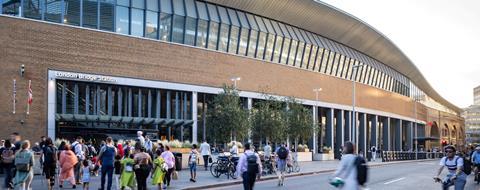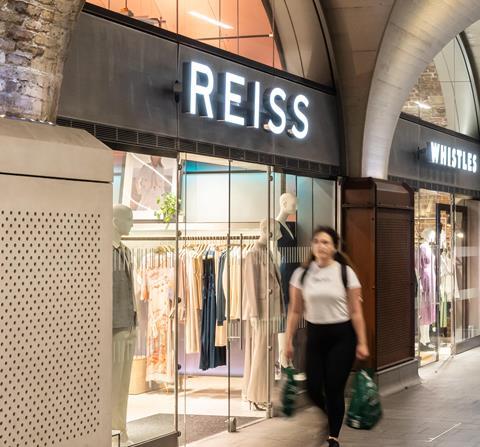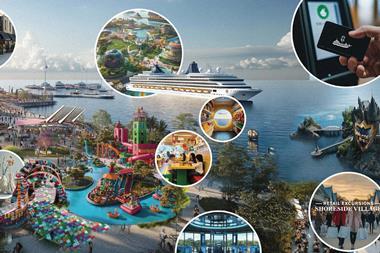Retail is everywhere. It has presence on high streets, shopping centres, retail parks and outlet villages, but it also appears in travel hubs such as airports and train stations.
While many consumers may not choose a mainline train station as their retail location of choice, the shops inside serve a purpose for those commuting, visiting, working, or living in the local area.
Network Rail, which manages 19 UK stations and raked in £842m in retail sales in the latest financial year, is on a mission to make stations an ultimate destination for passengers offering a mix of convenience, food and beverage, gifting, clothing, health and beauty, and leisure.

London Bridge’s redevelopment completed in early 2018 saw the addition of five new platforms, a new concourse, and 90 added retail units with some occupying the arches leading to the underground station.
Retail Week took a tour of Network Rail-managed station London Bridge, to discover its retail offering and gain insights into footfall, sales, customer demand and how it navigates the Christmas rush.
All aboard

Despite arriving at 2.30pm on a Thursday, London Bridge station was bustling with travellers and shoppers – there was also a large queue outside Greggs.
This isn’t an unusual sight according to Network Rail’s commercial director of property Hamish Kiernan, who says every demographic passes through every station at all times of the day.
“Post Covid-19, we’ve seen the passenger split change slightly,” he explains. “So where the commuter was five days a week, that’s now probably two or three days a week.
“We’re still seeing a lot (of sales) from stations that serve the north, as the dwell time is longer because people are on long distance trains. They tend to buy a book, or if they forget something like headphones, chargers, or their lunch, then they can buy that as well.”
Even though there are less commuters, deputy head of retail property at Network Rail Nicola Shepherd says that sales across all of its operated stations are up on pre-Covid-19 figures.
“That customer is coming in less, but they’re spending more money”
Nicola Shepherd, deputy head of retail property at Network Rail
“They may be bringing something home after time away, picking up food for the evening, making a purchase for themselves, or looking to free up time and buy gifts on route.”
With commuter numbers having dwindled since 2019, Network Rail says 59% of its passengers now travel for leisure and spend an average of £38 per visit.
Customers make up a major part of how Network Rail decides which retailers and brands should open in a station, with Shepherd adding that customers often help “push the boundaries” to bring in new, exciting players.

“In terms of London Bridge, we didn’t know how far we could push premium retail,” she says.
“Business as usual for us are the likes of Hotel Chocolat and Oliver Bonas, but we’ve introduced AllSaints, Whistles and Reiss and have been really pleased with the reactions from customers.”
She explains that shoppers are particularly enjoying the tech associated with the stores aimed at “making their lives easier” such as click and collect.
Christmas rush
Making that leap into setting up shop in train stations may not be easy for those retailers that are used to operating on high streets or in shopping centres.
Units in train stations open for longer hours and serve all different types of shoppers, with Network Rail’s retail team working closely with each retailer to work out the best product lines, speed of service, technology and customer needs.
“We share all of our data upfront, so there’s no surprises for the retailer and they know when peak times will be,” Shepherd reveals.
“Depending on where Christmas falls, we can see the peak travelling days, what time the long distance trains will go, and when commuters are travelling home”
Preparing for the busiest time in retail may prove more difficult when running a shop in a station, as planning for deliveries can’t interfere with passengers boarding their trains.
The Network Rail team and retailers have to ensure stock is delivered prior to the morning rush at 7.30am, and how to get the right products to maximise sales.
“We need to look at when shops need to have the most staff in operation, when peak time is, what is selling, why it is selling, and hopefully it means retail gets a big bump at Christmas, and then we’re ready for the next seasonal event,” she says.
The next stop is…
While many retailers haven’t considered becoming a tenant in a train station, Kiernan advises more to view it as a viable option.
“If you’re a true retailer and you want your till ringing, come and work in a railway station,” he urges.
“It’s like working a Saturday every day as there’s no downtime. From seven o’clock in the morning until the early hours, you’ve got people walking by and that is the key.”
He emphasises the importance of monitoring daily footfall as this data reveals which units are popular with customers. Sales data is particularly important as Network Rail bases rent prices of units on a percentage of a retailer’s turnover.

With many players including Greggs, Hotel Chocolat, Kiehl’s, Rituals, Boots, Costa, Pandora and social experiential operators such as Electric Shuffle, Kiernan says there is more to come.
“I’ve thrown some challenges and madcap ideas to my team, including one about possibly creating an outlet,” he says.
“Not quite like a Bicester Village, but due to our volume of passengers, we could have something like a Nike or Timberland outlet.
“It’s about finding and creating the space where people can be in and out easily, but we’re looking at everything all the time.”
With the introduction of premium retail, pop-ups and new leisure operators, the Network Rail team are confident London Bridge will help to generate sales of £1bn across all its stations next year.


























1 Reader's comment